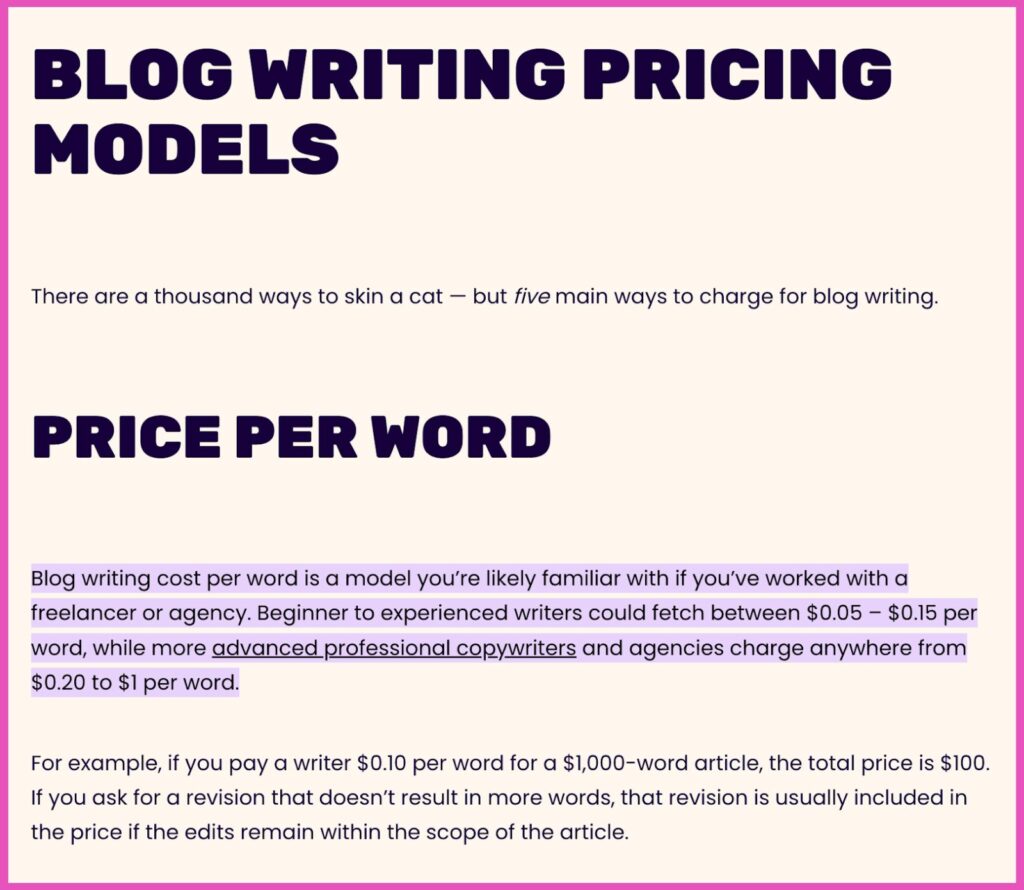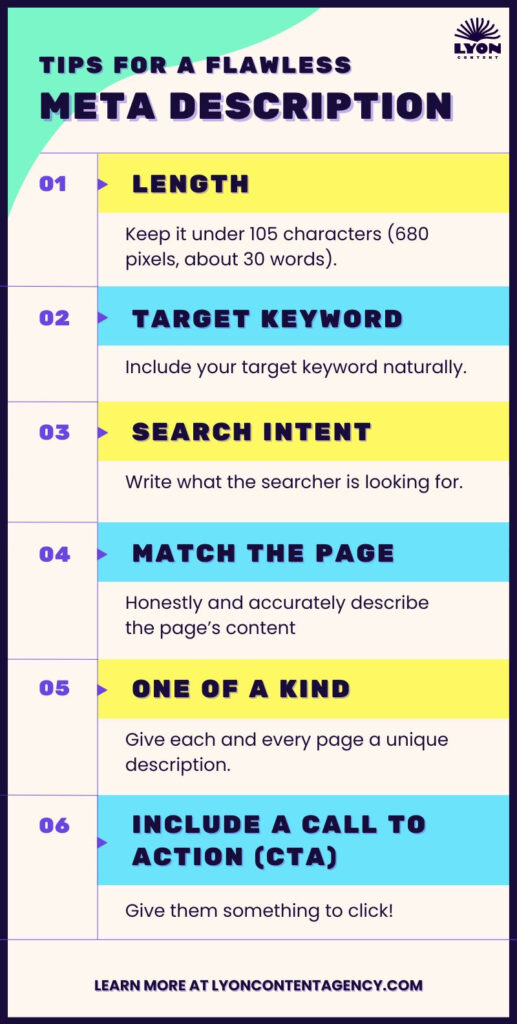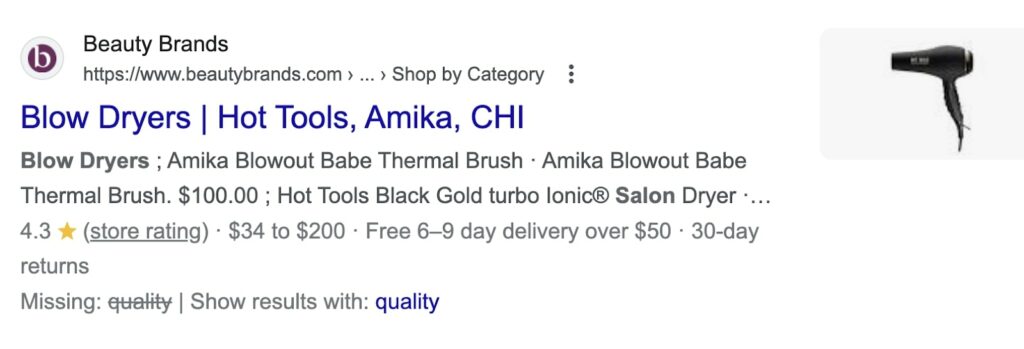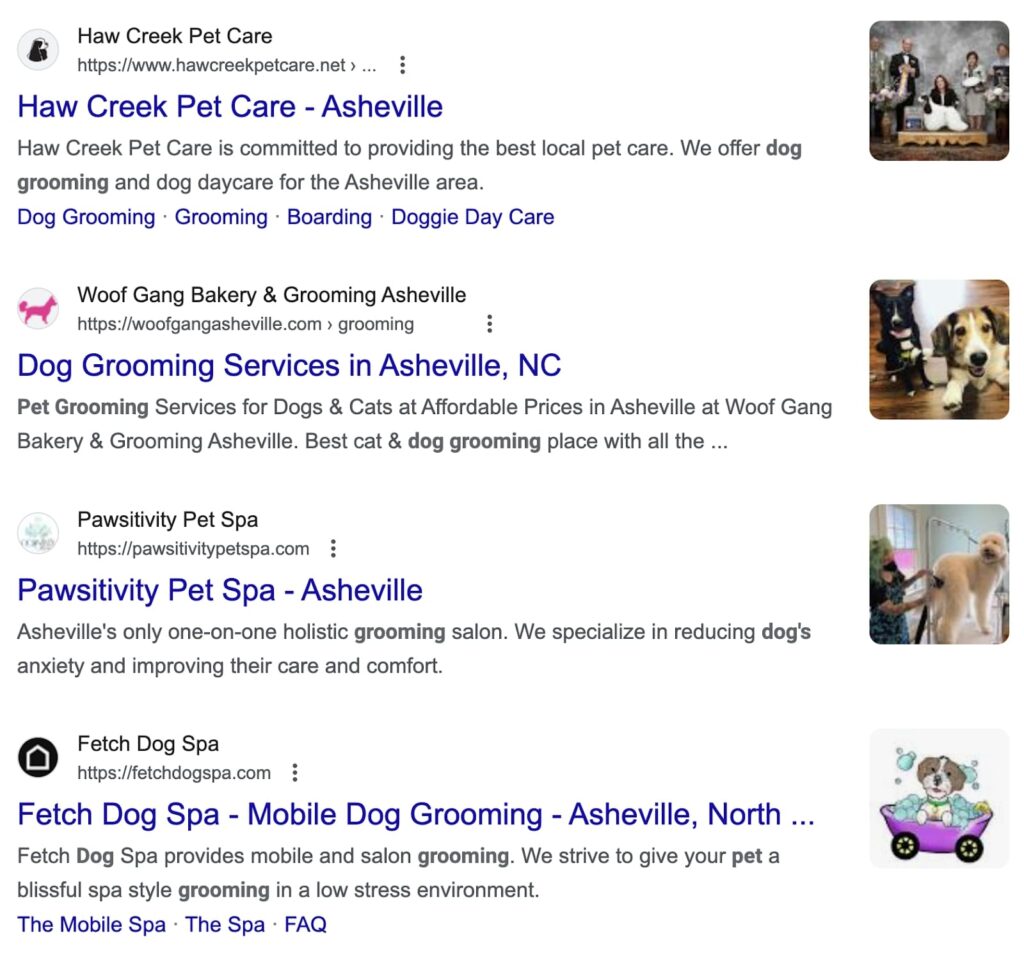What you’ll learn
You wouldn’t watch a new movie without seeing the trailer, so why would you publish a web page or article without a meta description? I get it; after completing the Herculean task of writing an article, who wants to fill in the little details AKA metadata? But if you don’t learn how to write a meta description for SEO, you might not get the click-through rate you desire.
Without this crucial info (meta title, meta description tag, headings) Google, search engines – and your audience – won’t know what your page is about. Instead, they’ll click on a competitors’ link enticed by its juicy meta description. Womp womp. We don’t want that.
Together with my content writing team, we’ve written thousands of articles and crafted compelling meta descriptions over a decade in content marketing.
Keep reading to learn how to write a meta description for SEO like the pros do, and get ready to watch the clicks and conversions soar.
What is a meta description?
A meta description is an HTML element (web page code) that briefly summarizes the contents of a web page, article, product page, category page, or any page on your website. They show up on the search engine results page (SERP) as small snippets of text beneath each result’s page title and URL, like this meta description for a product page:

How Google uses meta descriptions to generate snippets on the SERP
Sometimes, meta descriptions won’t appear exactly as you write them. That’s because in many cases, the meta description Google displays is one that the search engine generates based on your content, audience search intent, and parts of your submitted meta description.
If your meta description describes the content best, it will show on the SERP. Alternatively, Google may pull a sentence it feels most accurately represents the page.
For example, let’s look at our top-ranking article on blog writing costs. While we wrote a catchy meta description for this page, Google pulled a specific sentence to display on the SERP:

Above is the snippet Google automatically featured. Below is the meta description we wrote for this article:

And here is the content the browser finds when they click the link to our article:

Google chose to feature a sentence from the article that most aligned with the search intent: a paragraph explaining the range of blog writing costs.
So why is it important to learn how to write a meta description for SEO if Google is likely going to pull another sentence or phrase in its snippet?
Because the meta description we wrote informed Google of what the page is about, which helped Google pull the most descriptive snippet.
Bottom line? The contents of the page match the meta description and therefore, the SERP snippet, which contributes to this article’s top-3 place in the SERP.
TL:DR: Google chooses a meta description that most accurately summarizes the page’s content and features it as a snippet on the SERP.
Meta descriptions are fundamental to good on-page SEO. But why?
Why are meta descriptions important for SEO?
Meta descriptions instantly tell searchers what they’ll find once they click over to your site. They also help Google’s crawlers categorize your page.
When you craft descriptive and compelling meta descriptions, you get more clicks to your site (over your competitors’) which bolsters SEO and your click-through rate (CTR).
With this brand awareness, you’ll build authority and eventually see more conversions – bread and butter for SEO.
Meta descriptions don’t directly affect your site or page’s ranking, but they still support strong SEO by making your site accessible and user friendly.
Case in point?
Google bolds certain keywords they deem most relevant to the searcher’s query. For example, if someone types “natural mosquito-repellent” into Google, it may bold the keyword:

You can control your snippets by crafting killer meta descriptions.

How to write flawless SEO meta descriptions: 6 best practices
Here at Lyon Content, we love a good formula we can dissect, refine, and enhance. And you know sharing is caring, so here’s the secret sauce for how to write a meta description:
- Length: Under 105 characters (680 Pixels, about 30 words)
- Target keyword: Include it naturally
- Search intent: Write what the searcher is looking for
- Match the page: Honestly and accurately describe the page’s content
- One of a kind: Give each and every page a unique description
- Include a call to action (CTA): Give them something to click!
1. Character or Pixel Length
Google measures meta descriptions in pixel length (small graphic units). The sweet spot is 680 pixels (approximately 105 characters).
If your description is too long, it’ll automatically truncate in the snippet shown on the SERP. For example, this meta description for a blog page about iron-rich vegetables cuts off mid-sentence because despite its relevance, it surpassed 680 pixels:

We see details about the page’s content, but the mid-sentence break leaves the impression that important information might be missing. Meaning? People might not click to your page, which could cost you in decreased website traffic and CTRs.
Let’s look at a better example for a similar meta description:

This meta description might not list as many examples as the previous, but the sentence is complete and there are enough details to communicate what the page’s content is about.
Pixel length on desktop vs. mobile
As we unpack how to write a meta description, length also depends on the device your audience uses to type in search queries. A good rule of thumb is:
- Desktop: 960 pixels (~150 characters)
- Mobile: 680 pixels (~105 characters)
Problem is, you don’t get to write two separate meta descriptions for desktop vs. mobile. That’s why it’s smart to stick to the 680 pixel length to ensure that everyone can read your full meta description no matter which device they use.
Certain factors can stretch the space you have. For example, wider characters like “w” vs. “l”, and bolded keywords matching the search query that can take up more pixels.
Pro tip to avoid a truncated snippet: Google suggests specifying the maximum length you want to show up as a snippet on the SERP with the html meta tag “max-snippet: [number]”.
To avoid pertinent information getting axed, put the most important details at the beginning of your meta description.
Here’s a great example of an effective meta description from Dermstore for the search query: “best retinol brands”:

Why it works:
- Leads with a definition of retinol creams
- Promises a list of the best retinol creams and serums (notice how retinol creams is bolded; that’s because it’s the page’s primary keyword)
- Matches search intent with the first half offering the most value
2. Include your target keyword
It’s easy to forget to optimize your meta description with your primary keyword. But Google says it will showcase high-quality descriptions in the search results. As such, it’s essential to include your primary keyword naturally in your meta description.
Your target keyword is found within the search query you want to show up on the SERP for, and what will help browsers find your content.
Imagine someone searches for a luxury hair dryer. They type “salon-quality blow dryer” into Google Search. They scan the results and come across two very different snippets:
Option 1: Includes keyword

Option 2: Keyword is missing

There’s nothing wrong with either of these descriptions. However, one does edge out the other. Notice how the first one includes a keyword that matches the searcher’s intent?
We can see the bolded keywords “hair dryers”, “salon-quality”, and “blow dryers”, all in the meta description. The second option, however, highlights that the essential piece of the search term is missing: “quality” is crossed out meaning it’s not on the page.
Which do you think the searcher is going to click on? We can’t read every searcher’s mind, but we can look to the data to deduce what path they might take. If they want quality, they’re likely going to click on a meta description that contains that word.
Bonus points for option 1: I also love how much value NuMe packed into this meta description. They cover three critical features in this short meta description:
- They sell salon-quality hair dryers at the best price
- Their blow dryers use Far Infrared Heat tech
- They even offer a free gift
Bonus bonus points: Nothing is truncated! In just 153 characters (on desktop), NuMe descriptively highlights what I’ll find on the page.
Now that’s how to write a meta description for SEO!
3. Consider what the searcher wants (aka search intent)
Do you notice a common thread across all of these meta description best practices? It’s search intent, which I would argue is the lynchpin of all on-page SEO.
Search intent describes what the user wants to find when they type a phrase into Google.
It’s extremely straightforward: if someone wants to compare the best window air conditioners, they’re not going to type in “best split A/C units”, they’re going to type in “best window air conditioners”.
It really is that simple.
So what should they find on the SERP? Results comparing the highest rated window air conditioners, complete with product description specs, reviews, design features, pricing, and verdicts, like this article from USA Today Reviewed:

4. Make sure the description matches the page’s content
The meta description is the preview of what’s to come from the main event: the content on the page the searcher lands on.
Google wants you to write meta descriptions that contain relevant information about the webpage. It says: “A good meta description can bring all this data together.”
The data Google’s referring to? Details like:
- Product information
- Author and publication date
- Pricing and manufacturer details
When we break down how to write a meta description for SEO, a good place to start is to answer all of the critical questions about your webpage, such as:
- What is this page about?
- Why should the searcher click on this link over a competitors’?
- Does it include your primary keyword?
- What benefits does your content offer the searcher?
- What will they take away from clicking onto your page?
Answering these questions will help you write a helpful meta description that accurately matches the page’s content.
Another key factor of successful meta descriptions? Uniqueness.
5. Make each meta description 100% unique
How would you feel if you walked into a clothing store and only saw beige t-shirts lining the racks? My guess is unimpressed. The world has enough Millennial Grey and Sad Beige:

Similarly, people don’t want to read the same meta description on every page of your website. That’s because each page on your site should be unique. Creating blueprint copies of each page’s meta description won’t help searchers distinguish one page from the other.
And if they can’t do that, they’ll click on a competitors’ page which has unique meta descriptions for each product page, article, and core web page.
But I get it: writing meta descriptions is daunting and time-consuming. And while you could consider using AI to write them for you, you risk publishing bland meta descriptions that don’t do your pages justice.
After all, Google asks for “unique descriptions for each page of your site,” not boring, vanilla robo-generated fluff or duplicate meta descriptions.
I’ve seen it time and time again when new clients come to us. They’ve got dozens of pages without meta descriptions, with duplicate meta descriptions, or leave it up to Google to automatically generate one, and wonder why their site health score is low.
As seasoned SEO content writers, we know that saying more with less is key for crafting good meta descriptions. So next time you consider publishing a shiny new web page, run it by us first. We’ll compose strategic meta descriptions that are too tempting not to click on.
6. Include a catchy call to action (CTA)
The purpose of your meta description is to get searchers to do something. CTAs tell them precisely what to do. Popular meta description CTAs include tasks like:
- Shop now
- Book a consultation
- Learn more
- Start a free trial
- Get free shipping
Notice how all of the examples above use a strong verb like “shop”, “buy”, or “learn”? This is deliberate. With simple, direct, persuasive language, you’ll influence your audience to take action.
For example:
- Weak CTA: We sell beautiful bronzers in our online store in all shade seasons. We even offer free shipping when you make your first purchase.
- Strong CTA: Glow instantly with our sun-kissed bronzers in seasonal shades. Shop now and get free shipping on your first order!
Which would you click on?
Alright, I’ve taught you all the juicy details about how to write a good meta description. But the proof is in the puddin’.
5 Meta Description Examples to Increase Click-Through Rates
Ready to rev up the creative juices? Use these fantastic meta description examples to inspire your SEO strategy.
Example 1: The product meta description

Keyword: “natural hair growth serum”
Search intent: Commercial – this browser intends to make a purchase but needs to find the right brand first.
Why it works: There’s no shortage of hair growth oils, serums, and products. Vegamour’s meta description stands out because it instantly hooks browsers by addressing their pain point: they want thicker, fuller hair fast. It also builds credibility as a bestseller, and lists conscious ingredient labels for savvy buyers.
Example 2: The service meta description

Search intent: Informational – this browser wants to learn more and weigh their options.
Keyword: “content writing agency for beauty brands”
Why it works: It instantly addresses the searcher’s intent: to find out which content writing agencies are best for beauty brands. Then it promises to provide informational value by answering all the details about what makes a great beauty writing agency, including quality, ratings and pricing.
Example 3: The local business

Search intent: Commercial – the searcher is looking for info and comparing options.
Keyword: “dog grooming near me”
Why it works: I wanted to toss a nod to a small business, but Petco wins here because this is a flawless and actionable meta description. Most local businesses on the SERP listed what they do without a CTA. Petco’s meta description incites action immediately by asking their audience to schedule an appointment. Then they list their services.
There were some worthy runner ups, but I couldn’t help but wish all of the below meta descriptions were more action-oriented:

All of these are strong starts, they just need strong verbs and a solid CTA to inspire the browser to click to their site – especially when they’re listed after a commercial retailer like Petco.
Example 4: SaaS meta description

Search intent: Informational
Keyword: “affordable invoice software”
Why it works: In just 151 characters, Wave relates to the browser’s pain point beautifully: this invoicing software promises to save small businesses and freelancers the one commodity they’re always short on: time. Managing finances is stressful, but Wave offers a “stress-free” choice. And most importantly? It gets them paid. This meta description understands its intended audience through and through. Plus, it showcases its stellar 9.4 star rating and offers 1209 customer reviews – exactly the social proof an informational search intent browser would be looking for.
Example 5: The “ready-to-buy” meta description

Search intent: Transactional
Keyword: “Away luggage price”
Why it works: This browser is ready to make a purchase, they just want a little more info about the pricing. Away has already built a commanding industry reputation as a reliable luggage brand. So the meta description here provides further product details to help the browser make a transaction. It invites them to shop, has a customer rating, reviews, and lists pricing information along with shipping times. It also has quick links to the various categories in their online store. That’s a smooth flight to the checkout page.
Common Mistakes When Writing Meta Descriptions
We’ve looked at some stellar meta description examples, walked through the process of writing them, and covered best practices. So what’s the worst thing you can do to sabotage your meta descriptions? Turns out, there are a few faux-pas to sidestep:
- Not matching the user’s intent: Google pulls results based on how well your page aligns with the searcher’s query. So, it only makes sense that the worst way to rank is to write a meta description that is irrelevant to the searcher.
- Only putting brand or product details and code: While writing this article, I noticed that many local businesses only list their contact details. Without big-name brand awareness (like the Petco example above) people don’t care about contacting you because they are still in the research phase. Save your contact details for your contact page.
- Not writing them: Google looks for information from your metadata. Don’t make search engines guess what your content contains. Write a meta description to retain control and ensure that all of your SEO boxes are checked.

Helpful Meta Description Tools
It can be hard to keep tabs on all of your site’s pages, let alone the meta descriptions on all those pages. There are some excellent meta description tools to help you streamline your efforts, save time, and avoid critical SEO errors.
Here’s a roundup of our favorites:
- Site Audit: Semrush’s Site Audit is every marketer’s BFF. It audits your entire site to evaluate technical aspects like slow pages, errors, and missing metadata. It’ll highlight any missing meta descriptions you need to add to your web pages.
- Rank Math: This free Wordpress SEO plugin is a final quality control checkpoint for your website. Simply install it to your Wordpress CMS and it’ll evaluate each page for common SEO touchpoints like keyword density, readability, content length, and – you guessed it – your meta description.
- Yoast: This is another Wordpress plugin for your SEO. It shows you the ideal meta description length, alerts you if you need to add the page’s primary keyword, and makes additional content suggestions.
- AI SEO tools: If you’re struggling to come up with an effective meta description, recruit help from tools like ChatGPT or Frase AI. Keep in mind that AI copy will be basic and sometimes cringey. Use it as a brainstorming tool to see the formula of top-ranking meta descriptions, but we always recommend writing your own meta descriptions to stand out from competitors.
FAQs
Does every page need a meta description?
Yes, every page needs a unique meta description to help Google and browsers understand what your page is about. While Google will auto-generate its own snippet based on the user’s search intent and page content, meta descriptions help search engine crawlers categorize your content for better rankings.
Can I use the same meta description for multiple pages?
No, because this will undermine each page’s value and make it confusing for search engines to know how to rank your content. Duplicate meta descriptions don’t differentiate one page from the other, which could dilute your SEO efforts and lower your rankings.
What should be avoided in a meta description?
Don’t surpass the character limit of 150 characters or else your meta description might get cut off. Also make sure the meta description has a primary keyword, and matches the user’s search intent and the page’s contents. Lastly, you should always write a meta description that offers value and summarizes the page’s content. Don’t simply list your product or brand’s details, pricing, or location.
Increase your CTR with Kickass Meta Descriptions!
Mastering how to write a meta description for SEO comes down to understanding your audience’s search intent. To do that, you need to do audience research and have impeccable brand messaging.
Every meta description should work overtime to entice clicks to your website from your audience. Once there, you’ll dazzle them with your relatable website copy and superb offerings.
But first, you need them to click to your site. Tired of getting ghosted on the SERP? You know we’ve got you covered.

07/10/2024
Christina Lyon is the founder and CEO of Lyon Content. She’s fired up for helping brands kickass online and grow their digital empires. Christina lives in So Cal with her husband and two dogs, and nerds out on reading, traveling, writing creative fiction, and getting lost in wild places. She’s obsessed with a good underdog story and eats more rice bowls than she’s willing to admit.




